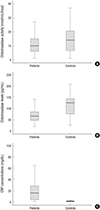1. Zadeh N, Getzug T, Grody WW. Diagnosis and management of familial Mediterranean fever: integrating medical genetics in a dedicated interdisciplinary clinic. Genet Med. 2011; 13:263–269.
2. Shohat M, Halpern GJ. Familial Mediterranean fever--a review. Genet Med. 2011; 13:487–498.
3. Doğan HO, Koca Y, Erden G, Karaaslan Y, Bozat H. Evaluating MEFV mutation frequency in Turkish familial Mediterranean fever suspected patients and gender correlation: a retrospective study. Mol Biol Rep. 2012; 39:6193–6196.
4. Koo KY, Park SJ, Wang JY, Shin JI, Jeong HJ, Lim BJ, Lee JS. The first case of familial Mediterranean fever associated with renal amyloidosis in Korea. Yonsei Med J. 2012; 53:454–458.
5. Martinon F, Tschopp J. Inflammatory caspases: linking an intracellular innate immune system to autoinflammatory diseases. Cell. 2004; 117:561–574.
6. Henderson C, Goldbach-Mansky R. Monogenic autoinflammatory diseases: new insights into clinical aspects and pathogenesis. Curr Opin Rheumatol. 2010; 22:567–578.
7. Netea MG, Simon A, van de Veerdonk F, Kullberg BJ, Van der Meer JW, Joosten LA. IL-1beta processing in host defense: beyond the inflammasomes. PLoS Pathog. 2010; 6:e1000661.
8. Gasparyan AY, Ayvazyan L, Yessirkepov M, Kitas GD. Colchicine as an anti-inflammatory and cardioprotective agent. Expert Opin Drug Metab Toxicol. 2015; 11:1781–1794.
9. Alanbay I, Ercan CM, Sakinci M, Coksuer H, Ozturk M, Tapan S. A macrophage activation marker chitotriosidase in women with PCOS: does low-grade chronic inflammation in PCOS relate to PCOS itself or obesity? Arch Gynecol Obstet. 2012; 286:1065–1071.
10. Guo Y, He W, Boer AM, Wevers RA, de Bruijn AM, Groener JE, Hollak CE, Aerts JM, Galjaard H, van Diggelen OP. Elevated plasma chitotriosidase activity in various lysosomal storage disorders. J Inherit Metab Dis. 1995; 18:717–722.
11. Barone R, Di Gregorio F, Romeo MA, Schilirò G, Pavone L. Plasma chitotriosidase activity in patients with beta-thalassemia. Blood Cells Mol Dis. 1999; 25:1–8.
12. Boot RG, Hollak CE, Verhoek M, Alberts C, Jonkers RE, Aerts JM. Plasma chitotriosidase and CCL18 as surrogate markers for granulomatous macrophages in sarcoidosis. Clin Chim Acta. 2010; 411:31–36.
13. Kurt YG, Cayci T, Onguru P, Akgul EO, Yaman H, Aydin I, Bodur H, Turker T, Kurt I, Cevik MA, et al. Serum chitotriosidase enzyme activity in patients with Crimean-Congo hemorrhagic fever. Clin Chem Lab Med. 2009; 47:1543–1547.
14. Malaguarnera L. Chitotriosidase: the yin and yang. Cell Mol Life Sci. 2006; 63:3018–3029.
15. Livneh A, Langevitz P, Zemer D, Zaks N, Kees S, Lidar T, Migdal A, Padeh S, Pras M. Criteria for the diagnosis of familial MedFiterranean fever. Arthritis Rheum. 1997; 40:1879–1885.
16. Wajner A, Michelin K, Burin MG, Pires RF, Pereira ML, Giugliani R, Coelho JC. Biochemical characterization of chitotriosidase enzyme: comparison between normal individuals and patients with Gaucher and with Niemann-Pick diseases. Clin Biochem. 2004; 37:893–897.
17. van Eijk M, van Roomen CP, Renkema GH, Bussink AP, Andrews L, Blommaart EF, Sugar A, Verhoeven AJ, Boot RG, Aerts JM. Characterization of human phagocyte-derived chitotriosidase, a component of innate immunity. Int Immunol. 2005; 17:1505–1512.
18. Labadaridis I, Dimitriou E, Theodorakis M, Kafalidis G, Velegraki A, Michelakakis H. Chitotriosidase in neonates with fungal and bacterial infections. Arch Dis Child Fetal Neonatal Ed. 2005; 90:F531–2.
19. Stehlik C, Reed JC. The PYRIN connection: novel players in innate immunity and inflammation. J Exp Med. 2004; 200:551–558.
20. Liepinsh E, Barbals R, Dahl E, Sharipo A, Staub E, Otting G. The death-domain fold of the ASC PYRIN domain, presenting a basis for PYRIN/PYRIN recognition. J Mol Biol. 2003; 332:1155–1163.
21. Pras M. Familial Mediterranean fever: from the clinical syndrome to the cloning of the pyrin gene. Scand J Rheumatol. 1998; 27:92–97.
22. Taylan A, Gurler O, Toprak B, Sisman AR, Yalcin H, Colak A, Sari I. S1000A12, chitotriosidase, and resolvin D1 as potential biomarkers of familial Mediterranean fever. J Korean Med Sci. 2015; 30:1241–1245.
23. Renkema GH, Boot RG, Strijland A, Donker-Koopman WE, van den Berg M, Muijsers AO, Aerts JM. Synthesis, sorting, and processing into distinct isoforms of human macrophage chitotriosidase. Eur J Biochem. 1997; 244:279–285.
24. Boot RG, Renkema GH, Strijland A, van Zonneveld AJ, Aerts JM. Cloning of a cDNA encoding chitotriosidase, a human chitinase produced by macrophages. J Biol Chem. 1995; 270:26252–26256.
25. Hollak CE, van Weely S, van Oers MH, Aerts JM. Marked elevation of plasma chitotriosidase activity. A novel hallmark of Gaucher disease. J Clin Invest. 1994; 93:1288–1292.
26. Czartoryska B, Fiszer U, Lugowska A. Chitotriosidase activity in cerebrospinal fluid as a marker of inflammatory processes in neurological diseases. J Lab Med. 2001; 25:77–81.
27. Grattagliano I, Bonfrate L, Ruggiero V, Scaccianoce G, Palasciano G, Portincasa P. Novel therapeutics for the treatment of familial Mediterranean fever: from colchicine to biologics. Clin Pharmacol Ther. 2014; 95:89–97.
28. Korkmaz C, Ozdogan H, Kasapçopur O, Yazici H. Acute phase response in familial Mediterranean fever. Ann Rheum Dis. 2002; 61:79–81.







 PDF
PDF ePub
ePub Citation
Citation Print
Print



 XML Download
XML Download